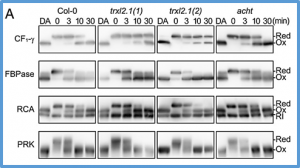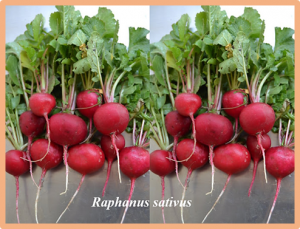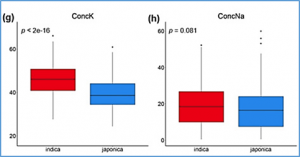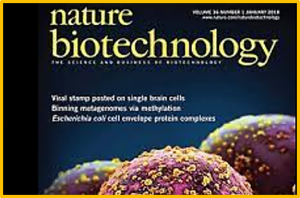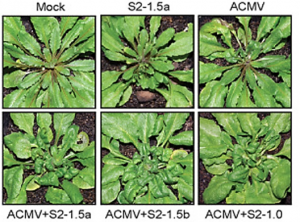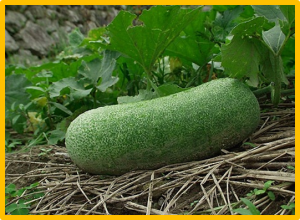Multi-omics prediction has been shown to be superior to genomic prediction with genome-wide DNA-based genetic markers (G) for predicting phenotypes. However, most of the existing studies were based on historical datasets from one environment; therefore, they were unable to evaluate the efficiency of multi-omics prediction in multi-environment trials and distantly related populations. To fill those gaps, we designed a systematic experiment to collect omics data and evaluate 17 traits in two oat breeding populations planted in single and multiple environments.
Thioredoxin (Trx) is a protein that mediates the reducing power transfer from the photosynthetic electron transport system to target enzymes in chloroplasts and regulates their activities. Redox regulation governed by Trx is a system that is central to the adaptation of various chloroplast functions to the ever-changing light environment. However, the factors involved in the opposite reaction (i.e., the oxidation of various enzymes) have yet to be revealed. Recently, it has been suggested that Trx and Trx-like proteins could oxidize Trx-targeted proteins in vitro. To elucidate the in vivo function of these proteins as oxidation factors, we generated mutant plant lines deficient in Trx or Trx-like proteins and studied how the proteins are involved in oxidative regulation in chloroplasts.
Chiral asymmetry is important in a wide variety of disciplines and occurs across length scales. While several natural chiral biomolecules exist only with single handedness, they can produce complex hierarchical structures with opposite chiralities. Understanding how the handedness is transferred from molecular to the macroscopic scales is far from trivial. An intriguing example is the transfer of the handedness of helicoidal organizations of cellulose microfibrils in plant cell walls. All previously reported examples of a helicoidal structure in plants are left-handed except, remarkably, in the Pollia condensata fruit; both left- and right-handed helicoidal cell walls are found in neighboring cells of the same tissue.
Fusarium wilt (FW) caused by Fusarium oxysporum f. sp. raphani is an important disease in radish, leading to severe decrease in yield and quality. YR4 as a novel genetic source to resistant to FW was confirmed through screening with five pathogen isolates. We have generated F2 and F2:3 populations segregated with FW resistance using YR4 and YR18 inbred lines. The disease symptom was evaluated in F2:3 population (n = 180) in three independent studies over two years.
Drought is a common abiotic stress for terrestrial plants and often affects crop development and yield. Recent studies have suggested that lignin plays a crucial role in plant drought tolerance; however, the underlying molecular mechanisms are still largely unknown. Here, we report that the rice (Oryza sativa) gene CINNAMOYL-CoA REDUCTASE 10 (OsCCR10) is directly activated by the OsNAC5 transcription factor, which mediates drought tolerance through regulating lignin accumulation
Rice tolerance to salinity stress involves diverse and complementary mechanisms, such as the regulation of genome expression, activation of specific ion-transport systems to manage excess sodium at the cell or plant level, and anatomical changes that avoid sodium penetration into the inner tissues of the plant. These complementary mechanisms can act synergistically to improve salinity tolerance in the plant,
The targeted deletion, replacement, integration or inversion of genomic sequences could be used to study or treat human genetic diseases, but existing methods typically require double-strand DNA breaks (DSBs) that lead to undesired consequences, including uncontrolled indel mixtures and chromosomal abnormalities. Here we describe twin prime editing (twinPE), a DSB-independent method that uses a prime editor protein and two prime editing guide RNAs (pegRNAs)
Cassava mosaic disease (CMD), which is caused by single-stranded DNA begomoviruses, severely limits cassava production across Africa. A previous study showed that CMD symptom severity and viral DNA accumulation increase in cassava in the presence of a DNA sequence designated SEGS-2 (sequence enhancing geminivirus symptoms). We report here that when SEGS-2 is coinoculated with African cassava mosaic virus (ACMV) onto Arabidopsis thaliana, viral symptoms increase. Transgenic Arabidopsis with an integrated copy of SEGS-2 inoculated with ACMV also display increased symptom severity and viral DNA levels. Moreover, SEGS-2 enables Cabbage leaf curl virus (CaLCuV) to infect a geminivirus-resistant Arabidopsis thaliana accession.
Fruit shape is an important agronomic trait in wax gourds. Therefore, in this study, we employed bulked segregant analysis (BSA) to identify a candidate gene for fruit shape in wax gourds within F2 populations derived by crossing GX-71 (long cylindrical fruit, fruit shape index = 4.56) and MY-1 (round fruit, fruit shape index = 1.06) genotypes. According to BSA, the candidate gene is located in the 17.18 Mb region on chromosome 2. Meanwhile, kompetitive allele-specific PCR (KASP) markers were used to reduce it to a 19.6 Kb region. Only one gene was present within the corresponding region of the reference genome, namely Bch02G016830 (designated BFS). Subsequently, BFS was sequenced in six wax gourd varieties with different fruit shapes.
TL28-1 is a novel spontaneous wax-deficient mutant with a glossy phenotype identified from cabbage. In this study, the genetic analysis suggested that the wax-deficient trait of TL28-1 was controlled by a single recessive gene. All wax monomers longer than 28 carbons were significantly decreased in TL28-1. Fine-mapping results showed that the wax-deficient locus wdtl28 was located at an 80-kb interval between BOL01-20 and BOL01-24 markers on chromosome 1.


 Curently online :
Curently online :
 Total visitors :
Total visitors :

